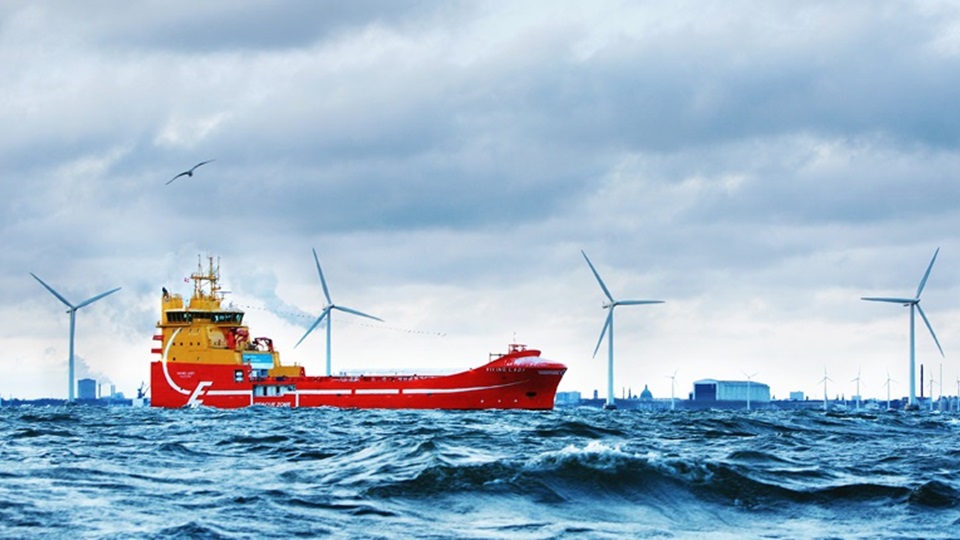
Viking Lady
The Viking Lady platform supply vessel embodies a number of groundbreaking, energy efficient, and emissions reducing technologies.
The 92 m platform supply vessel combines four Wärtsilä 32DF dual-fuel engines with advanced vessel automation and Wärtsilä’s innovative Low Loss Concept, which minimizes electrical losses. The vessel runs on liquefied natural gas (LNG), a cleaner fuel that significantly reduces NOX and CO2 emissions.The accommodation block and wheelhouse are placed aft for greater crew comfort and safety. Together with an oil recovery capacity of 2500 m3, this means that it complies with a number of classification notations, including Clean Design, Nautical OSV and Comfort Class.
In March 2012, DNV announced that a true hybrid energy system is currently being developed for installation on board the offshore supply vessel Viking Lady. An impressive battery pack for energy storage will soon be installed. When the new system is complete, the operation of the engine will be more smooth and cost effective giving further emission reductions.
The three-year-old LNG-fuelled vessel, which is owned by Eidesvik Offshore, was the very first merchant ship to use a fuel cell as part of its propulsion system. The fuel cell, which generates an electric output of 330 kW, was installed in the autumn of 2009 and has successfully run for more than 18,500 hours. Based on this, the Viking Lady is already one of the world’s most environmentally friendly ships.
Another first step is to be taken to reduce its emissions even more. Once the battery pack is in place, the ship will operate using a hybrid system similar to that which has been installed in hybrid cars for a number of years. However, the potential emission reductions are higher and the return on investment period is shorter for ships than it is for cars.
DNV is heading this research project, which is called FellowSHIP. Its partners are Eidesvik Offshore, the owner of the ship and Wärtsilä, who provides power solutions for the marine market. In this, the next project phase, an energy storage capability is to be introduced to the energy system. This allows the benefits of a true hybrid energy system to be explored.
The primary potential benefits of the hybrid energy system for a ship like the Viking Lady are a 20/30% reduction in fuel consumption and CO2 emissions through smoother and more efficient operation of the engines and fuel cell. The reductions of other exhaust components are even higher.
The whole shipping industry is currently facing record-high fuel costs. Based on these actual costs, the return on investment period for the hybrid system is estimated to be less than two years.
Bjørn-Johan Vartdal, DNV’s project manager says:
“We know that the hybrid system will reduce the energy consumption. When operating, for example, on dynamic positioning, there will be a major fuel saving potential. When in harbour, too, the ship should be able to operate on the fuel cell and its battery power alone, which will reduce emissions significantly. For environmentally sensitive areas, this will be an essential benefit. Additional benefits are related to reductions in machinery maintenance costs and in noise and vibrations.”
A comprehensive measurement program will be carried out to verify the savings potential. The hybrid system will also be modelled in detail. Calibrated and verified process models will facilitate simulation and optimization of future hybrid systems.
The new DNV class rules for battery-powered ships have been developed in parallel to this. These are the first class rules developed in order for batteries to be used as part of a vessel’s propulsion energy - both as hybrid solutions and for “pure” battery-driven vessels.
During 2014 Low Loss Hybrid has been installed and demonstrated onboard Platform Supply Vessel Viking Lady. The savings in fuel and reduction in emissions in various vessel operating conditions have been documented through a comprehensive measurement program. The following operations have been tested:
- Transit mode in heavy weather conditions where the battery is used to reduce frequent load variations on the engines and one genset less in operaton becasue higher average load can be maintained.
- Critical operation where the battery is used as power redundancy as well as adopting a charge/discharge strategy allowing one engine and one battery to operate at efficient loads in addition to reducing frequent load variations.
- Waiting/standby on the field.
By introducing a hybrid energy system onboard Viking Lady, we have reduced the fuel consumption by 15%. For Viking Lady this would give an estimated payback time of less than 4 years for the hybrid system. The emission reductions are also substantial, and in particular local emissions in the harbour will be virtually eliminated if used during stay in harbour.
